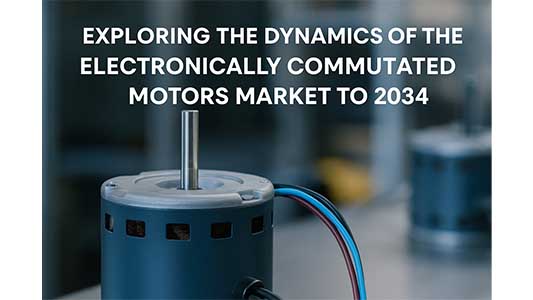In the pursuit of energy efficiency and precision-driven operations, electronically commutated (EC) motors have emerged as a quiet revolution. These motors, which blend the efficiency of brushless DC motors with the intelligence of electronic control, are steadily becoming the backbone of modern machinery—from HVAC systems to industrial automation, electric vehicles, and household appliances.
According to recent industry research, the Electronically Commutated Motors Market was valued at US$ 5.7 billion in 2023 and is projected to reach approximately US$ 11.8 billion by 2034, expanding at a compound annual growth rate (CAGR) of 6.9%. This growth trajectory signals not only a robust demand but also reflects a broader shift in industries toward energy-efficient, compact, and digitally controlled motor solutions.
What Are Electronically Commutated Motors, and Why Do They Matter?
EC motors are essentially permanent magnet brushless DC motors that are controlled electronically, rather than using mechanical brushes and commutators. The result? Higher efficiency, longer life span, less maintenance, and quieter operations.
But their biggest strength lies in precise speed control and energy efficiency. These motors can adjust speed and torque automatically, optimizing performance based on real-time demand. This makes them a favorite in HVAC, refrigeration, automotive, robotics, and even medical devices, where variable speed, lower power consumption, and longevity are critical.
As sustainability takes center stage, industries are increasingly moving away from traditional induction motors in favor of EC motors. Regulatory standards and green building codes across North America, Europe, and parts of Asia are also mandating the use of energy-efficient components—further catalyzing this transition.
Market Growth Drivers: Why Demand is Accelerating
The EC motors market is benefiting from several converging trends:
1. Energy Efficiency Mandates
Government initiatives and environmental regulations are driving manufacturers to adopt motors that consume less energy. EC motors are up to 30% more efficient than their conventional counterparts, which directly translates to lower operational costs and smaller carbon footprints.
2. HVAC and Refrigeration Demand
As commercial buildings, data centers, and residential infrastructures scale globally, HVAC systems are growing more sophisticated. EC motors offer adaptive performance and substantial energy savings in these applications. With EC motors now used in fan arrays, compressors, and pumps, this segment is expected to be a major revenue contributor through 2034.
3. Rise of Smart Manufacturing and Industry 4.0
Automation is no longer optional—it’s essential. In smart factories, EC motors help deliver high-precision motion control in robotics, conveyors, and tooling machinery. Their ability to integrate with IoT systems and predictive maintenance tools makes them indispensable in the modern manufacturing setup.
4. Electrification of Vehicles and Transportation
The global push toward electric vehicles (EVs) has indirectly favored the EC motor market. While traction motors in EVs are often more powerful and specific, EC motors play a crucial role in auxiliary systems like cooling pumps, HVAC blowers, and power steering units.
Competitive Landscape: Innovation at the Core
The EC motors market is fiercely competitive, featuring both global giants and specialized regional players. The dominant strategy among these players is relentless innovation—developing more compact, intelligent, and cost-efficient motors that suit diverse applications.
Key Players in the Market:
- ABB Group
- Siemens AG
- Weg
- Parker Hannifin Corp.
- Nidec Motor Corporation
- ASTRO Motorengesellschaft mbH & Co. KG
- ALLIED MOTION TECHNOLOGIES INC.
- Maxon Motor AG
- Bühler Motor GmbH
- Kollmorgen Corp
These companies are not only enhancing motor design but are also focusing on software-driven performance, IoT-enabled diagnostics, and energy compliance certifications.
Strategic Moves by Market Leaders:
ABB’s EC Titanium Launch
In March 2023, ABB introduced EC Titanium motors, a next-generation integrated motor-drive system available in NEMA and IEC frames. These motors are designed with highly efficient rotor technology and come with features like an IP55 enclosure, integrated drive, and internal shaft grounding brush. When paired with ABB’s ACH580 variable speed drive, these motors offer a highly sustainable solution for fan arrays—especially in HVAC systems.
Nidec’s Strategic Acquisition
In July 2023, Nidec completed the acquisition of Houma Armature Works, a U.S.-based motor remanufacturing and field service company. This strategic acquisition strengthens Nidec’s footprint in the oil & gas and renewable energy segments, giving it deeper access to high-end clients that rely on complex motor solutions—many of which fall under Nidec’s existing brand umbrella (Kato Engineering, Leroy-Somer, US Motors).
These developments reflect the focus on vertical integration, localization of manufacturing, and aftermarket service support, which are key to long-term dominance in this market.
Regional Outlook: Where the Growth Is Happening
North America:
The region continues to be a frontrunner, thanks to strong HVAC infrastructure demand and rapid industrial automation. U.S. regulations on motor efficiency are also driving EC motor penetration in commercial and residential spaces.
Europe:
Known for strict energy efficiency standards, Europe remains a hotbed for EC motor adoption—especially in HVAC, ventilation systems, and energy-efficient buildings. Countries like Germany and France are investing heavily in green infrastructure.
Asia-Pacific:
This is the fastest-growing regional market, driven by China’s manufacturing boom, India’s industrial modernization, and rapid urbanization across Southeast Asia. The demand for efficient HVAC systems and automotive innovations is spurring EC motor growth in this region.
Challenges Ahead: Not Without Roadblocks
Despite the optimistic outlook, the market isn’t without its challenges:
- High Initial Cost: EC motors, due to their complex electronics and advanced design, are more expensive upfront than traditional AC motors. This can be a barrier, especially in cost-sensitive markets.
- Technical Complexity: Installation and maintenance require skilled technicians familiar with electronic control systems.
- Supply Chain Disruptions: Ongoing issues with semiconductor availability and global logistics can slow down production and delivery cycles.
However, these hurdles are being steadily addressed as economies of scale improve and awareness spreads about the long-term savings and benefits of EC motors.
The Road Ahead: Smarter, Greener, and More Integrated
As we approach 2034, EC motors will not just be a premium option—they will become the default standard in many industrial and commercial settings. Their ability to deliver intelligent performance, energy savings, and operational flexibility makes them a crucial component in the global transition toward sustainable engineering and automation.
With strong R&D pipelines, strategic partnerships, and aggressive expansion plans, market leaders are setting the stage for a new era of motor technology—one that is digitally connected, resource-efficient, and globally scalable.
Final Thought
The Electronically Commutated Motors Market is on the cusp of a transformation. It’s no longer about just rotating machinery; it’s about intelligent systems that work smarter, last longer, and do more with less. For manufacturers, investors, and policymakers alike, this market offers a clear opportunity: a future where energy efficiency, automation, and smart control converge into one powerful, compact package.
These insights are based on a report on the by Electronically Commutated Motors Market Transparency Market Research (TMR).













